All too often, shoe shoppers are so elated to find their right size that they neglect to consider the width of their shoes. Yet to ensure maximum comfort, getting the width just right is important. So let your fingers do the walking down this page to find shoe width charts, measuring instructions, and helpful pointers on how to track down the best fitting shoes.
At A Glance: Understanding Shoe Size Width
- Importance of Width: Shoe width is a crucial factor in finding the perfect fit. In the US, shoes come in up to nine different widths, ranging from AAA (narrowest) to EEE (widest).
- Width Variations: Shoe width varies based on gender. For men, a D width is considered medium, while for women, it’s considered wide. Similarly, E width is wide for men and extra-wide for women.
- Measuring Shoe Width: To measure your shoe width, place your foot on a sheet of paper and trace around it. Identify and mark the widest part of your foot on the tracing. Measure the distance between the marked points with a ruler to determine the width of your foot.
- Children’s Shoe Width: Children’s shoes also come in various widths, from medium/average to extra-wide. It’s important to measure a child’s foot accurately to ensure a comfortable fit.
Men’s Shoe Width Chart
| US Size | Narrow (C) | Average (D) | Wide (E) |
|---|---|---|---|
| 6 | 3 5⁄16" | 3 1⁄2" | 3 11⁄16" |
| 6.5 | 3 5⁄16" | 3 5⁄8" | 3 3⁄4" |
| 7 | 3 3⁄8" | 3 5⁄8" | 3 3⁄4" |
| 7.5 | 3 3⁄8" | 3 11⁄16" | 3 15⁄16" |
| 8 | 3 1⁄2" | 3 3⁄4" | 3 15⁄16" |
| 8.5 | 3 5⁄8" | 3 3⁄4" | 4" |
| 9 | 3 5⁄8" | 3 15⁄16" | 4 1⁄8" |
| 9.5 | 3 11⁄16" | 3 15⁄16" | 4 1⁄8" |
| 10 | 3 3⁄4" | 4" | 4 3⁄16" |
| 10.5 | 3 3⁄4" | 4 1⁄8" | 4 5⁄16" |
| 11 | 3 14⁄16" | 4 1⁄8" | 4 6⁄16" |
| 11.5 | 3 14⁄16" | 4 3⁄16" | 4 8⁄16" |
| 12 | 3 14⁄16" | 4 4⁄16" | 4 10⁄16" |
| 12.5 | 3 15⁄16" | 4 5⁄16" | 4 10⁄16" |
| 13 | 4" | 4 6⁄16" | 4 12⁄16" |
| 13.5 | 4 1⁄16" | 4 7⁄16" | 4 13⁄16" |
| 14 | 4 2⁄16" | 4 8⁄16" | 4 14⁄16" |
| 14.5 | 4 3⁄16" | 4 9⁄16" | 4 14⁄16" |
| 15 | 4 4⁄16" | 4 10⁄16" | 4 14⁄16" |
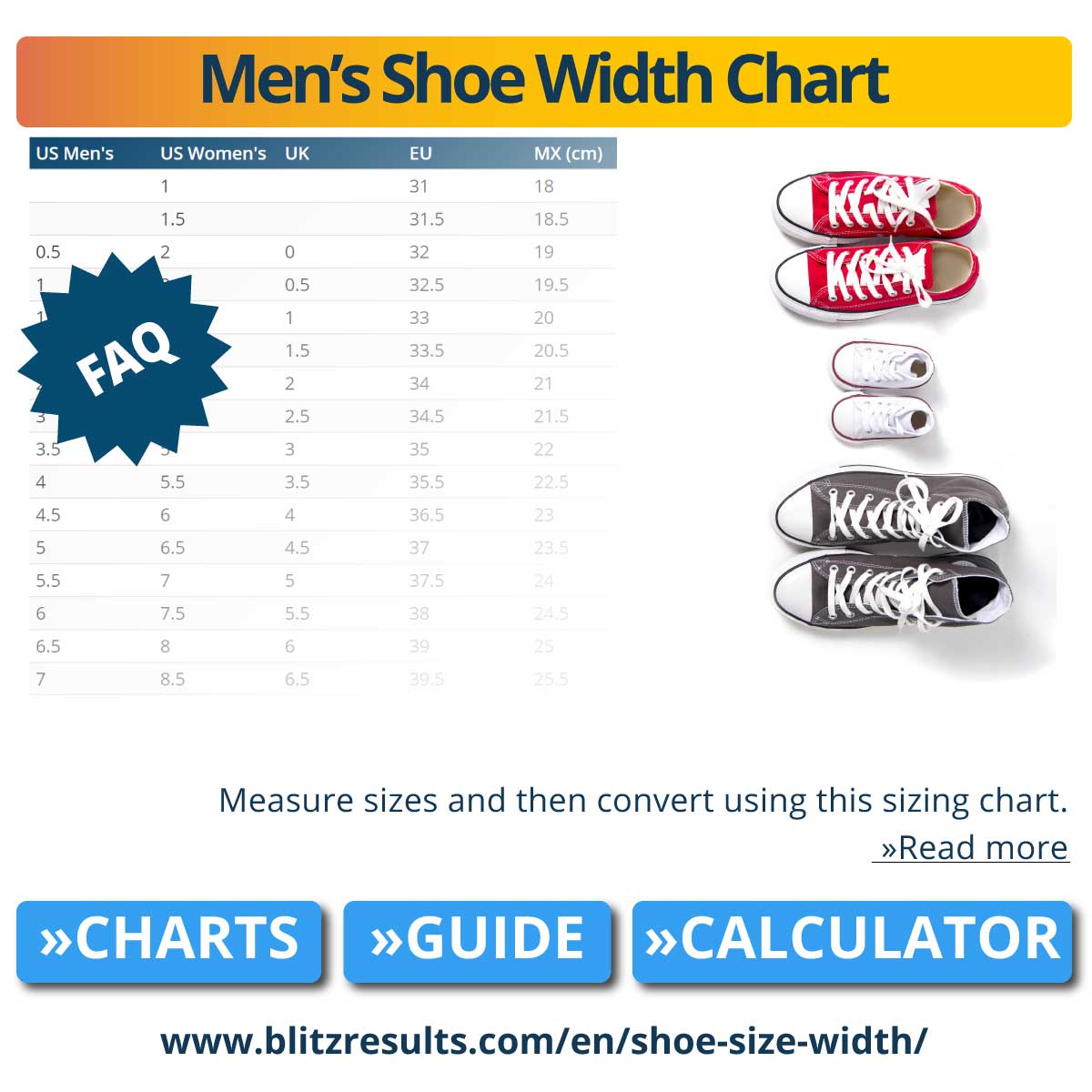
For men, a shoe width D is considered medium-size, but for women it’s on the wide side. Going up the scale, E width is regarded as wide for men, and extra-wide for women. EE width shoes are extra wide for both men and women, and were once hard for women to find, although more companies have offered them in recent decades.
Men’s Shoe Width by the Letter
| Letter | Width | Abbreviation |
|---|---|---|
| B | Narrow | N |
| D | Medium or Average | M or A |
| 2E or EE | Wide | W |
| 4E or EEEE | Extra-Wide | WW or XW or EW |
Women’s Shoe Width Chart
| US Size | Narrow (AA) | Average (B) | Wide (C/D) | Extra-Wide (E) |
|---|---|---|---|---|
| 5 | 2 13/16" | 3 3/16" | 3 9/16" | 3 15/16" |
| 5.5 | 2 7/8" | 3 1/4" | 3 5/8" | 4" |
| 6 | 2 15/16" | 3 5/16" | 3 11/16" | 4 1/16" |
| 6.5 | 3" | 3 3/8" | 3 3/4" | 4 1/8" |
| 7 | 3 1/16" | 3 7/16" | 3 13/16" | 4 3/16" |
| 7.5 | 3 1/8" | 3 1/2" | 3 7/8" | 4 1/4" |
| 8 | 3 3/16" | 3 9/16" | 3 15/16" | 4 5/16" |
| 8.5 | 3 1/4" | 3 5/8" | 4" | 4 3/8" |
| 9 | 3 3/8" | 3 11/16" | 4 1/16" | 4 7/16" |
| 9.5 | 3 3/8" | 3 3/4" | 4 1/8" | 4 1/2" |
| 10 | 3 7/16" | 3 3/4" | 4 3/16" | 4 9/16" |
| 10.5 | 3 1/2" | 3 7/8" | 4 1/4" | 4 5/8" |
| 11 | 3 9/16" | 3 15/16" | 4 5/16" | 4 11/16" |
| 12 | 3 11/16" | 4 1/16" | 4 7/16" | 4 13/16" |
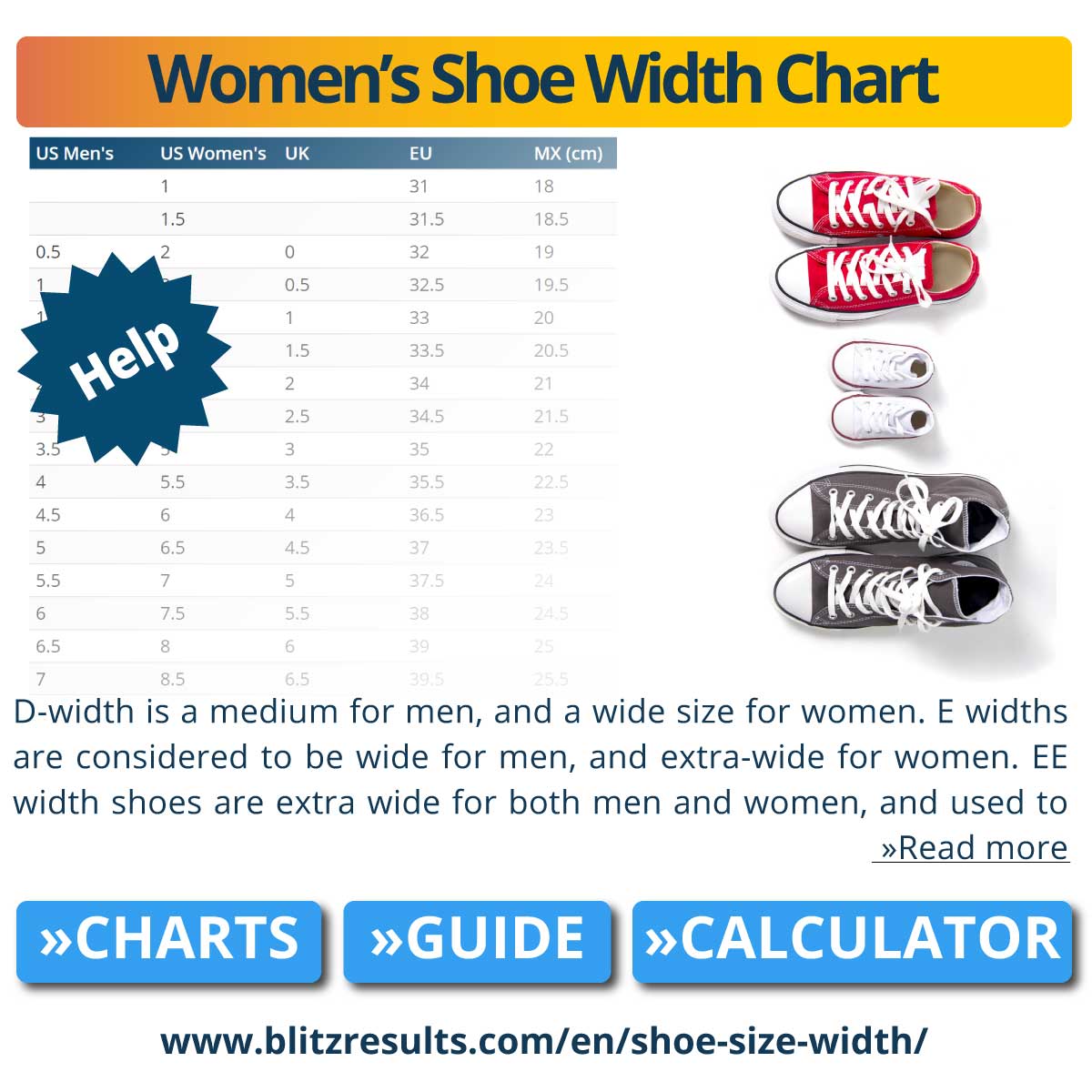
What’s the difference between men’s and women’s shoe widths? Men usually have wider feet, so a medium width for a man is a D whereas women’s feet are typically smaller and proportionally narrower, making medium width for a woman a B. Take a good look at the charts on this page for more details on how width varies based on gender.
Women’s Shoe Width by the Letter
| Letter | Width | Abbreviation |
|---|---|---|
| 4A or AAAA | Super-Slim (Extra-Narrow) | SS, ES |
| 2A or AA | Narrow | N |
| B | Medium or Average | M or A |
| D | Wide | W |
| 2E or EE | Extra-Wide | WW or XW or EW |
Children’s Shoe Width Chart
| US Size | Average (B) | Wide (D) | Extra-Wide (E) |
|---|---|---|---|
| 1 | 1 7/8" | 2 1/4" | 2 7/16" |
| 1.5 | 1 7/8" | 2 1/4" | 2 7/16" |
| 2 | 2" | 2 3/8" | 2 9/16" |
| 2.5 | 2" | 2 3/8" | 2 9/16" |
| 3 | 2 1/8" | 2 7/16" | 2 5/8" |
| 3.5 | 2 1/8" | 2 7/16" | 2 5/8" |
| 4 | 2 3/16" | 2 9/16" | 2 3/4" |
| 4.5 | 2 3/16" | 2 9/16" | 2 3/4" |
| 5 | 2 1/4" | 2 5/8" | 2 13/16" |
| 5.5 | 2 1/4" | 2 11/16" | 2 7/8" |
| 6 | 2 5/16" | 2 3/4" | 2 15/16" |
| 6.5 | 2 3/8" | 2 3/4" | 2 15/16" |
| 7 | 2 7/16" | 2 13/16" | 3" |
| 7.5 | 2 1/2" | 2 7/8" | 3 1/16" |
| 8 | 2 1/2" | 2 15/16" | 3 1/16" |
| 8.5 | 2 9/16" | 3" | 3 3/16" |
| 9 | 2 5/8" | 3" | 3 3/16" |
| 9.5 | 2 11/16" | 3 1/16" | 3 1/4" |
| 10 | 2 3/4" | 3 1/8" | 3 5/16" |
| 10.5 | 2 3/4" | 3 3/16" | 3 3/8" |
| 11 | 2 13/16" | 3 1/4" | 3 1/2" |
| 11.5 | 2 7/8" | 3 5/16" | 3 1/2" |
| 12 | 2 15/16" | 3 3/8" | 3 9/16" |
| 12.5 | 3" | 3 7/16" | 3 5/8" |
| 13 | 3 1/16" | 3 1/2" | 3 11/16" |
| 13.5 | 3 1/8" | 3 9/16" | 3 3/4" |
| 1Y | 3 3/16" | 3 5/8" | 3 3/16" |
| 1.5Y | 3 1/4" | 3 11/16" | 3 7/8" |
| 2Y | 3 5/16" | 3 3/4" | 3 15/16" |
| 2.5Y | 3 3/8" | 3 13/16" | 4" |
| 3Y | 3 7/16" | 3 7/8" | 4 1/16" |
| 3.5Y | 3 1/2" | 3 15/16" | 4 1/16" |
| 4Y | 3 9/16" | 4" | 4 3/16" |
| 4.5Y | 3 5/8" | 4 1/16" | 4 1/4" |
| 5Y | 3 11/16" | 4 1/8" | 4 5/16" |
| 5.5Y | 3 3/4" | 4 3/16" | 4 3/8" |
| 6Y | 3 3/16" | 4 1/4" | 4 7/16" |
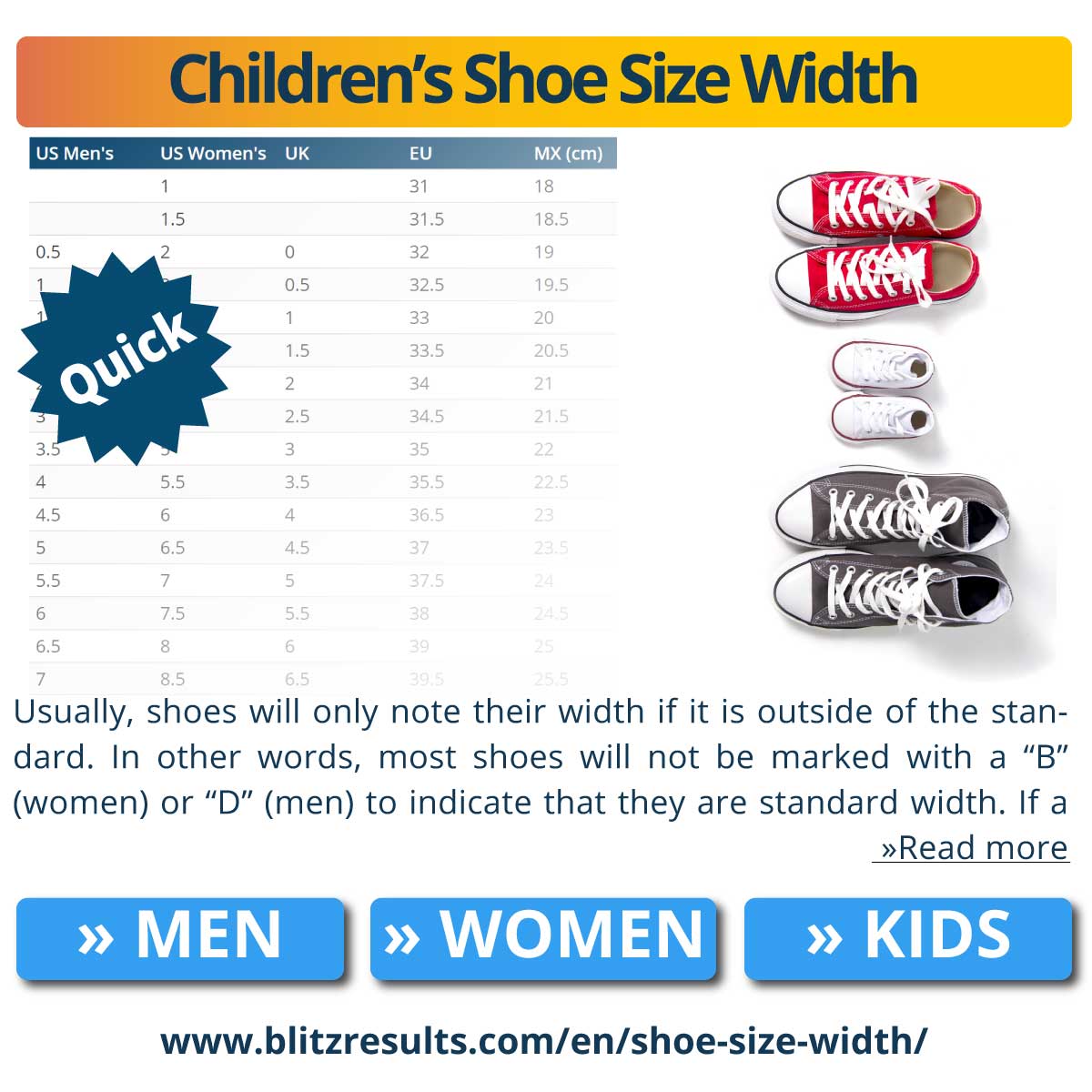
The width of children’s shoes ranges from medium/average to extra-wide. Use this conversion chart to find the right size.
Children’s Shoe Width by the Letter
| Letter | Width | Abbreviation |
|---|---|---|
| M | Medium or Average | M |
| W | Wide | W |
| XW | Extra-Wide | WW or XW or EW |
How To Measure Your Shoe Width
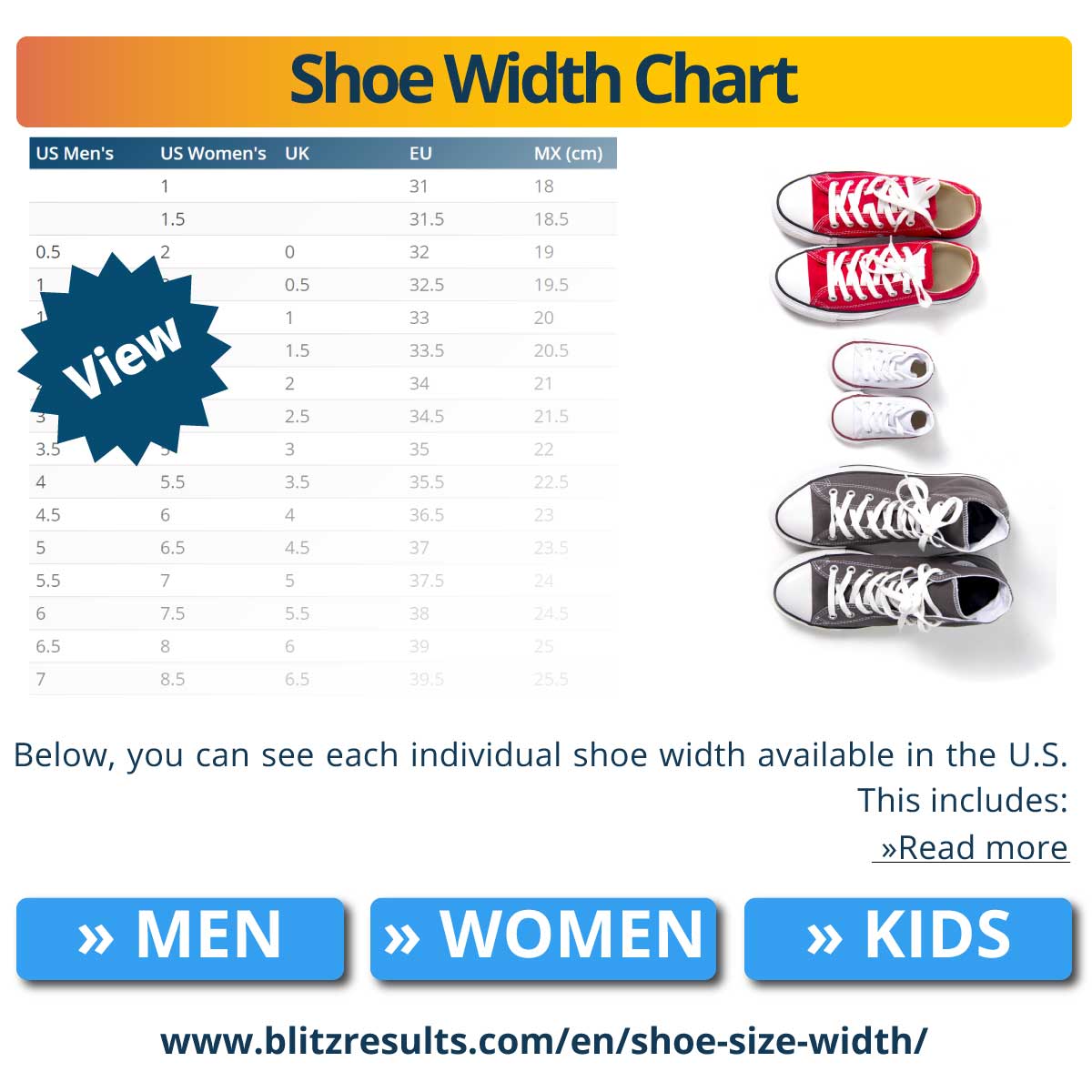
If you can’t make it to a physical, bricks-and-mortar shoe store, you can measure your shoe width on your own. To get the best results, make sure you measure both feet because one can be wider than the other.
- Prepare the Paper: Place the paper on a flat, hard surface. Ensure there’s enough space for your foot to fit completely on the paper.
- Stand on the Paper: With socks on (or barefoot, depending on how you usually wear your shoes), stand on the paper. Your foot should be flat, and your weight should be distributed normally.
- Trace Your Foot: Carefully trace around your foot using the pen or pencil. Try to keep the pen or pencil perpendicular to the paper to get the most accurate outline. It’s often easier if someone else can do this for you.
- Mark the Widest Part: Look at the tracing of your foot and identify the widest part, which is typically across the ball of the foot. Mark these points on both sides of your foot outline.
- Measure the Width: Using the ruler or measuring tape, measure the distance between the two points you marked in the previous step. This is the width of your foot.
FAQ
What Does D Mean in Shoe Width?
As noted above, a D width for men falls in the average range, and consequently, will often not appear on the shoe or the shoebox. For women, a D represents a wide width shoe, which will likely be indicated on the shoe’s label under the tongue. Finally, look up your width on the shoe width tables on this page.
What Does Narrow Mean in Shoe Width?
If your foot is narrow, it means the width is less than that of the average width foot, and will generally be indicated with the letter size B for men and A or AA for women.
What Does EE Mean in Shoe Width?
EE designates an extra-wide shoe width for both men and women. While long available for men, the size was formerly difficult to find for women, but in recent years manufacturers have offered it more often.
How Do I Measure My Shoe Width?
Be sure to measure both bare feet, as one can be wider than the other. Place your foot on a sheet of paper and trace its outline. Measure the distance across the widest part of the tracing to determine your shoe width. Finally, look up your width on the shoe width tables on this page.
What Is The Average Shoe Width?
About 90% of the population have “normal” width feet. Statistically speaking, if you’re not sure of your foot width, there’s a good (9 times out of 10) chance that you wear a normal width shoe – a B for women and a D for men. Shoe makers generally only note the width of shoes that fall outside of the standard range. If a shoe is not marked with a width, it is probably safe to assume it is standard. However, for those in need of non-standard widths, those measurements are often marked on the shoe boxes and the label underneath the tongue of the shoe.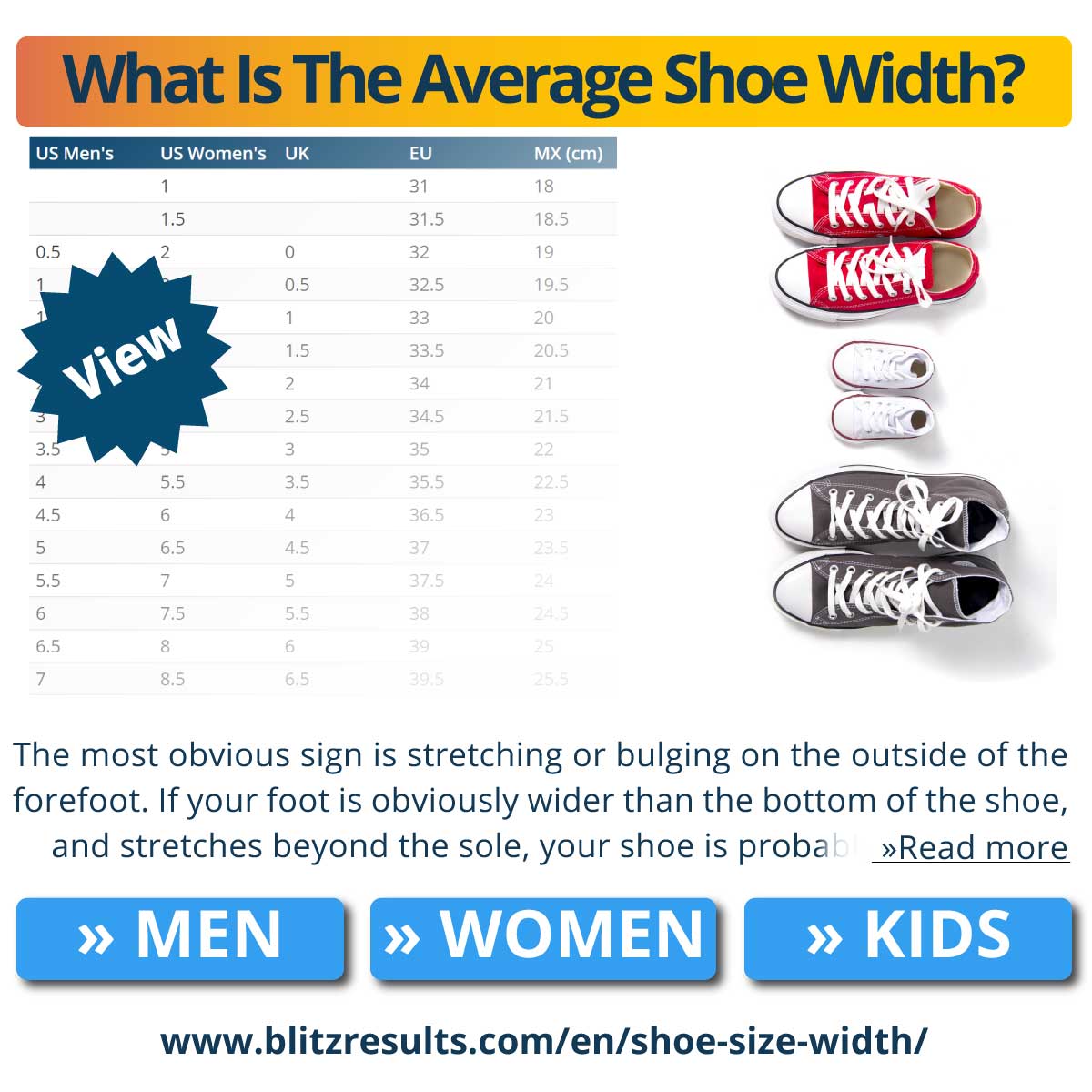
How Can You Tell If You Need a Wider Shoe?
The most obvious sign is stretching or bulging on the outside of the forefoot. If your foot is visibly wider than the bottom of the shoe, stretching beyond the sole, your shoe is probably too narrow.
Most running and training shoes can be purchased in a variety of widths. In addition, men can buy women’s styles for a narrower fit, and women can buy men’s shoes for a wider one.
What Happens If My Shoes Are Too Narrow?
Too-tight shoes can lead to a variety of health issues, like cramps, infected foot sores, foot deformities, hammertoes, and bunions. Excessive sweating, which can lead to bacterial or fungal infections, is also a common issue.
What Happens If My Shoes Are Too Wide?
Loose-fitting shoes can also be problematic. Standing still or in motion, you’ll wind up off-balance and unstable. While walking or running, your feet can move around inside your shoes, causing friction that can lead to sores and blisters, perhaps even a bone spur. Nail problems and hammertoes are also common issues with overly-wide shoes.
Insights from our Lab
This is how we work: watch the video and see how we measure and research in our lab.
